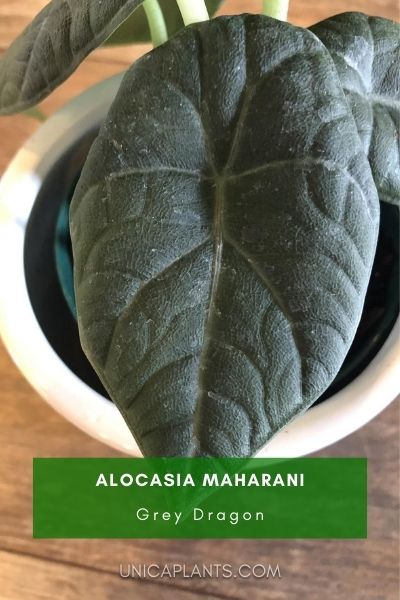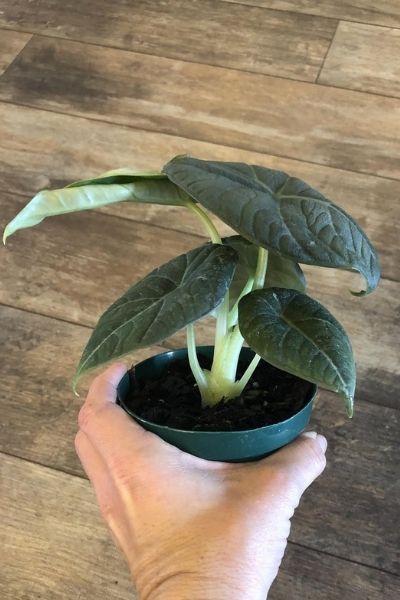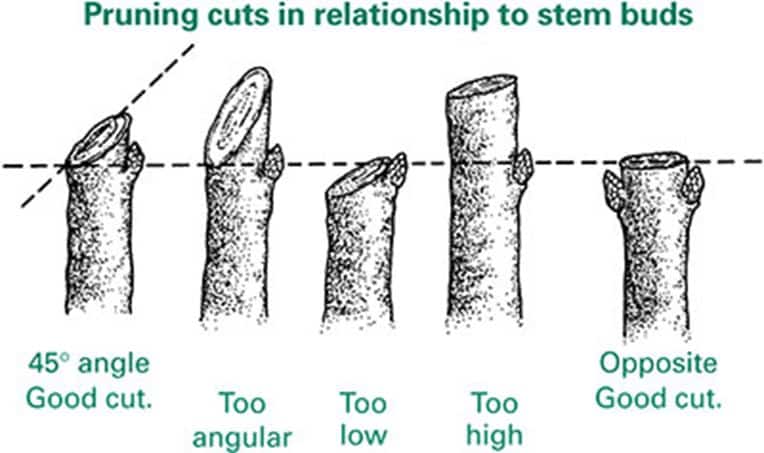The Alocasia maharani (also known as the "Grey Dragon" or "Indian Princess") is one of my most favorite Jewel Alocasias. In this Alocasia maharani care guide, I will go over everything you need to know to successfully grow the Grey Dragon plant.
The Alocasia maharani grows best in medium to bright indirect sunlight with temperatures between 65 and 80ºF (18 and 27ºC). It likes a well-draining soil mix and only needs to be watered once the top 2 inches of the soil are dry. Fertilizer can be given once per month (only during spring and summer).
After a new leaf unfurls, it transforms from a bright green fragile leaf into a thick dark green leaf that actually feels hard on top and has a bright green underside with a reddish tint. The leaves have a rough texture with a lot of veins running over them. The Grey Dragon will be a great addition to any aroid collection!
The Grey Dragon is native to Southeast Asia and, when kept in a plant pot or container, can reach a maximum height of about 14" (35 cm) with leaves that grow up to 6" (15 cm) long. Due to the relatively small size of this plant, it can be presented as a houseplant on a shelf or in a terrarium.
Images by Ashley Reichwein from FancyPlantsyLLC.

Summary:
- Light: Bright indirect sunlight
- Water: Only water when the top 2 inches of the soil are dry
- Soil: Well-draining soil mix
- Fertilizer: Once a month (during growing seasons)
- Size: Grows up to 14" (35 cm) tall
- Size: Leaves grow up to 6" (15 cm) long
- Temperature: Between 65 and 80ºF (18 and 27ºC)
- Humidity: At least 60%
- Cold hardy: Not cold hardy
- Propagation: By division, offsets, and seeds
- Toxicity: Toxic to humans and animals
Contents
- General Care for Alocasia maharani (Grey Dragon)
- Water
- Light
- Soil
- Repotting
- Fertilizer
- Humidity
- Temperature
- Common pests
- How to Propagate Alocasia maharani (Grey Dragon)
- Division
- Offsets
- Seeds
- Related questions:
- Why are the leaves of my Alocasia maharani turning brown?
- Can I propagate the Alocasia maharani from stem cuttings?
- Can I propagate the Alocasia maharani in water?
- Why are the leaves of my Alocasia maharani turning yellow?
- Why is my Alocasia maharani drooping?
- Why is my Alocasia maharani dropping leaves?
- Is the Alocasia maharani tocix to cats and dogs?
General Care for Alocasia maharani (Grey Dragon)
The Alocasia maharani is very similar to other alocasia plants when it comes to caring and propagation. Like other Alocasia plants, they need bright indirect sunlight and high humidity to remain happy.
Water
As far as watering goes it is really going to depend on the growing conditions, climate, and temperatures in regards to how much you should water the Alocasia maharani. But, in general, you only want to water the Alocasia Grey Dragon when the top 2 inches of the soil are dry.
In the spring and summer, this means you should water the plant about once every 5 days, and in the winter months about once every week.
When watering, keep the soil evenly moist and avoid overly saturated and waterlogged soil. Too much water in the soil will promote root rot, which will hurt the plant. Also don't let the soil dry out completely, as this will also hurt the plant.
An EASY method that I use to give my Alocasia plants exactly the amount of water that they need is by using a moisture probe. This probe will indicate how much moisture there is present in the soil. For all Alocasia plants, when the moisture probe indicates number 2, it's time to water the plant. Click here to check out the moisture probe on Etsy.
Light
This plant is known to grow on ground levels and underneath the canopy of jungle and forest areas where there is almost no direct sunlight and only a lot of medium to bright indirect sunlight.
This means that the Alocasia maharani grows best in bright indirect light but it can also tolerate medium levels of light. Place the plant a couple of feet next to a south-facing window or on a shelf or table where it will get bright indirect sunlight.
Keep the Grey Dragon away from direct sunlight because this will burn the leaves and make them brown.
Also, leaves are great at collecting dust. To ensure the plant can absorb the maximum amount of sunlight, you want to carefully clean the leaves of the plant with lukewarm water every 2-3 weeks.
Soil
For soil, you want to use a well-draining, aerated potting soil that is also able to retain some water. You can easily make a good soil mix at home with two parts perlite potting mix and one part coconut husk.
When the soil stays too wet, the roots aren't able to obtain any oxygen. This is often caused because the soil mix is too water retentive which will cause rotting issues with the roots.
If the top of the soil doesn't dry out after a week, the soil-mix that you are using may be too heavy. In this case, you want to add more perlite or coconut husk to the soil to make it more drainable.
Repotting
The Alocasia maharani likes to be slightly root-bound and doesn't need to be repotted every year because it's a slow grower.
If you are not sure if the plant needs to be repotted or not, you can easily find this out by checking the drainage holes of the container that it's in. If you can see the roots through the drainages holes, it's time for repotting.
When repotting the Grey Dragon, use a container that is 2 to 3 inches bigger than the previous one.
Fertilizer
Fertilizers contain essential nutrients that plants need to survive and grow. Plants get most of these nutrients from the soil that they're in. Over time, the amount of nutrients in the soil decrease as the plant uses these nutrients to grow. This is why your Alocasia "Grey Dragon" can benefit a fertilizer.
The Alocasia maharani only needs to be fertilized once every month (only during spring and summer). The best fertilizer that you can use is an organic fertilizer like worm castings (click here to check out the worm castings).
You can also use a diluted balanced chemical fertilizer (and always follow the instructions carefully).
Cease fertilization during the winter months because the plant will use fewer nutrients during these low-light and low-temperature times.
Fertilizing during the winter months or overfertilizing the Grey Dragon Alocasia will cause a nutrient overload which will burn the leaves or in the worst case kill the plant.
Humidity
Keeping the humidity levels high is really important for the Alocasia maharani. Because this plant is native to a tropical environment, it grows best in humidity levels of at least 60%. Higher humidity levels are always better (70%).
If the humidity levels are too low, the plant will develop brown spots on the leaves, crispy leaves, or begin to yellow.
You can do a couple of thing to increase the humidity around the plant, like:
- Mist the plant
- Use a humidifier
- Use a pebble tray (place the planters on a tray filled with rocks and water)
- Place the plant in a greenhouse
Temperature
The Grey Dragon does best in temperatures between 65 and 80ºF (18 and 27ºC). If you are growing this plant outdoors, you definitely want to take it indoors in the winter months when it constantly gets colder than 65ºF (18ºC).
The Alocasia maharani is very sensitive to colder temperatures and cold drafts. If the plant is constantly experiencing temperatures below 65ºF, it will first stop growing, then lose its leaves and in the worst-case scenario even die.
Common pests
Alocasia plants are generally prone to pests like mealy bugs, scale, aphids, and spider mites. However, the Alocasia maharani is a strong plant that doesn't get infected with a pest easily.
Oftentimes pests attack weak plants. By keeping your precious Alocasia in good condition (by caring for it in the right way) you will also ensure that pests stay away.
- One way to prevent pests from infesting your Alocasia is to keep the humidity high. This will not only keep the plant healthy and happy but will also keep pests away.
- Another way you can keep pests away and decrease the chance of fungal growth is by increasing ventilation around the plant.
If your plant is already infested with a pest, you can use a chemical or organic pesticide to get rid of the pest. The pesticide that I have had lots of success with is one with neem oil. Check out my shop where I have listed this pesticide!
If you like rare houseplants that are easy to care for, check out the Philodendron 'Burle Marx'

How to Propagate Alocasia maharani (Grey Dragon)
The Alocasia Grey Dragon can be propagated by either division, offsets, or seeds. Propagation should be done in spring or early summer and always make sure the plant is healthy before propagation.
Division
The simplest way to propagate the "Grey Dragon" is by division. There are three steps to a successful division.
- First, you want to take the plant out of its pot and carefully remove the soil around the roots.
- Then you want to split the rhizome utilizing a sharp blade. Make sure that there are the same amount of roots on the two sections of the plant.
- Lastly, prepare a well-draining soil mix and plant in a pot with drainage holes.
Now, care for the plant like written above and let the "Grey Dragon" grow!
Offsets
The Alocasia maharani can also be propagated by offsets, which develop all through the entire year and are really baby Alocasia plants.
If you want to use this method, take a sharp blade or a pair of sterile garden scissors. Now cut the roots that are connected to the mother plant. After you have cut the roots you can carefully pull the offset out of the soil and plant it a well-draining soil mix.
Tip: Don't start chopping away offsets (babies) when they are just new. Stand by till they're at least 1" (2.5 cm) tall before disconnecting them from the mother plant. The bigger the offset, the more success the propagation!
Seeds
When propagating from seed, soak the seeds overnight in distilled water and sow in a well-draining soil mix (in the fall).
- Sow the seeds 0.5" (~1cm) in the soil.
- After that, water the seeds lightly and put a plastic bag over the containers to provide high humidity.
- Place the pot with the seeds (and plastic bag) in bright indirect sunlight and keep the soil moist.
- Besides, you want to add a heat mat under the containers to keep the seedlings warm. The heat will improve the germination success rate.
After a couple of months, when the seedlings have grown to about 2" (5cm) tall, carefully transplant them into bigger pots and enjoy your baby Alocasia maharani!
Related questions:
Why are the leaves of my Alocasia maharani turning brown?
Brown leaves or brown spots on the leaves can be caused by low humidity levels (under 60%), dry soil, too much fertilizer, too much sun, leaf spot diseases, or pests. Here is a checklist on how to get rid of these brown spots:
- Increase the humidity by misting the plant with water 2 times a week or by using a humidifier.
- When it comes to watering, never let the soil dry out completely. Water again when the top 2 inches of the soil are dry.
- When using fertilizer, use a diluted balanced fertilizer once a month (ONLY in spring and summer).
- Place the Alocasia maharani in medium to bright indirect sunlight and avoid direct sunlight.
- Use an organic pesticide with neem oil.
Can I propagate the Alocasia maharani from stem cuttings?
No. The Alocasia maharani can't be propagated from stem cuttings. You can propagate it by either division, offsets, or seeds.
The easiest and most successful way to propagate the "Grey Dragon" is by division.
Can I propagate the Alocasia maharani in water?
Yes. You can do so by carefully pulling an offset out of the soil and putting it in a clean glass filled with water. Make sure the roots of the offset are submerged in water and give it bright indirect sunlight.
For the next weeks, you want to change the water once a week and when the roots are at least 2 inches (5 cm) long, you can plant the offset in a well-draining soil mix.
Why are the leaves of my Alocasia maharani turning yellow?
If your Alocasia maharani has yellow leaves, it’s probably an indication that the soil has been too wet or too dry. To prevent the leaves from turning yellow, only water the plant when the top 2 inches of the soil are dry. Or use a moisture probe and water it when the probe indicates between 2 and 3.
Why is my Alocasia maharani drooping?
If your Alocasia maharani is drooping it's often the effect of underwatering. Whenever water is not provided for longer periods of time, the water balance within the plant can get thrown off. This will cause the cells in the stems to lose their strength and the plant will start drooping.
Never let the soil of the plant completely dry out. Only water when the top 2 inches of the soil are dry.
Why is my Alocasia maharani dropping leaves?
The Alocasia maharani is either dropping its leaves when you under or overwater it. By only watering the plant when the top 2 inches of the soil are dry, you can prevent the plant from dropping its leaves.
Is the Alocasia maharani tocix to cats and dogs?
The Alocasia maharani is toxic to all pets (including pets and dogs). All parts of the plant contain calcium oxalate crystals which is an irritant to the mouth and esophagus when eaten.
If you liked this care guide, check out the Alocasia infernalis (Black Magic)



Leave a Reply